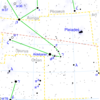In Ancient Indian astronomy, there are 27 nakshatras , or sectors along the ecliptic. A list of them is first found in the Vedanga Jyotisha, a text dated to the final centuries BCE[citation needed]. The Nakṣatra system predates the influence of Hellenistic astronomy on Vedic tradition, which became prevalent from about the 2nd century CE. There are various systems of enumerating the Nakṣatra-s;[clarification needed] although there are 27-28 days to a sidereal month, by custom only 27 days are used. The following list gives the corresponding regions of sky.[1] Months in the modern Indian national calendar -- despite still carrying names that derive from the nakshatras -- do not signify any material correlation. It stands to reason that during the original naming of these months -- whenever that happened -- they were indeed based on the nakshatras that coincided with them in some manner. The modern Indian national calendar is a solar calendar, much like the Gregorian calendar wherein solstices and equinoxes fall on the same date(s) every year.
| No. | Name | Associated stars | Description | Image |
|---|---|---|---|---|
| 1 | Ashvini - अश्विनी "physician to the Gods" |
β "Sheratan" and γ "Mesarthim" Arietis |
|

|
| 2 | Bharani - भरणी "the bearer" |
35, 39 "Lilii Borea", and 41 Arietis |
|

|
| 3 | Krittika - कृत्तिका an old name of the Pleiades; personified as the nurses of Kārttikeya, a son of Shiva. |
Pleiades | 
| |
| 4 | Rohini - रोहिणी "the red one", a name of Aldebaran. Also known as brāhmī |
Aldebaran |
|

|
| 5 | Mrigashira - मृगशिर "the deer's head". Also known as āgrahāyaṇī |
λ "Meissa", φ Orionis | 
| |
| 6 | Ardra - आर्द्रा "the storm god" |
Betelgeuse |
|

|
| 7 | Punarvasu - पुनर्वसु (dual) "the two restorers of goods", also known as yamakau "the two chariots" |
Castor and Pollux |
|

|
| 8 | Pushya - पुष्य "the nourisher", also known as sidhya or tiṣya |
γ "Asellus Borealis", δ "Asellus Australis" and θ Cancri | 
| |
| 9 | Āshleshā - आश्ळेषा/आश्लेषा "the embrace" |
δ, ε "Āshleshā Nakshatra", η, ρ, and σ "Minchir" Hydrae |
|

|
| 10 | Maghā - मघा "the bountiful" |
Regulus |
|

|
| 11 | Pūrva Phalgunī - पूर्व फाल्गुनी "first reddish one" |
δ "Zosma" and θ "Chertan" Leonis |
|

|
| 12 | Uttara Phalgunī - उत्तर फाल्गुनी "second reddish one" |
Denebola |
|

|
| 13 | Hasta - हस्त "the hand" |
α "Alchiba", β "Kraz", γ, δ "Algorab" and ε "Minkar" Corvi | 
| |
| 14 | Chitra - चित्रा "the bright one", a name of Spica |
Spica |
|

|
| 15 | Svati - स्वाति "Su-Ati (Sanskrit) Very good" name of Arcturus |
Arcturus |
|

|
| 16 | Vishakha - विशाखा "forked, having branches"; also known as rādhā "the gift" |
α "Zubenelgenubi", β "Zubeneschamali", γ and ι Librae | 
| |
| 17 | Anuradha - अनुराधा "following rādhā" |
β "Acrab", δ "Dschubba" and π "Fang" Scorpionis |
|

|
| 18 | Jyeshtha - ज्येष्ठा "the eldest, most excellent" |
α "Antares", σ, and τ "Paikauhale" Scorpionis |
|

|
| 19 | Mula - मूल "the root" |
ε "Larawag", ζ, η, θ "Sargas", ι, κ, λ "Shaula", μ and ν "Jabbah" Scorpionis |
|

|
| 20 | Purva Ashadha - पूर्व आषाढा "first of the āṣāḍhā", āṣāḍhā "the invincible one" being the name of a constellation |
δ "Kaus Media" and ε "Kaus Australis" Sagittarii |
|

|
| 21 | Uttara Ashadha - उत्तर आषाढा "Later invincible" |
ζ "Ascella" and σ "Nunki" Sagittarii |
|

|
| 22 | Shravana - श्रवण |
α "Altair", β and γ Aquilae |
|

|
| 23 | Dhanishta - श्रविष्ठा/धनिष्ठा "most famous", also Shravishthā "swiftest" |
α "Sualocin" to δ Delphini |
|

|
| 24 | Shatabhisha - शतभिष/शततारका "requiring a hundred physicians" |
γ Aquarii "Sadachbia" |
|

|
| 25 | Purva Bhadrapada - पूर्व भाद्रपदा/पूर्व प्रोष्ठपदा "the first of the blessed feet" |
α "Markab" and β Pegasi |
|

|
| 26 | Uttara Bhādrapadā - उत्तर भाद्रपदा/उत्तर प्रोष्ठपदा "the second of the blessed feet" |
γ "Algenib" Pegasi and α "Alpheratz" Andromedae |
|

|
| 27 | Revati - रेवती "prosperous" |
ζ Piscium "Revati" |
|

|
| 28 | Abhijit - अभिजित "Invincible" |
Lyra |
|

|
- ^ Basham, Arthur Llewellyn (1954). "Appendix II: Astronomy". The Wonder That Was India. Sidgwick and Jackson. p. 490.